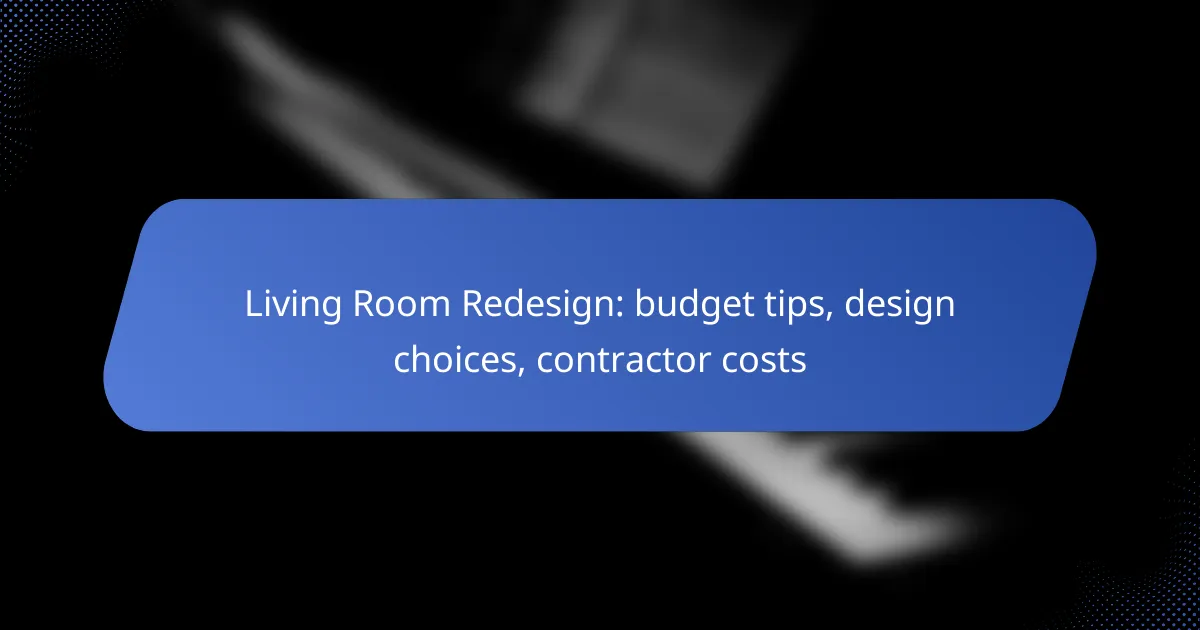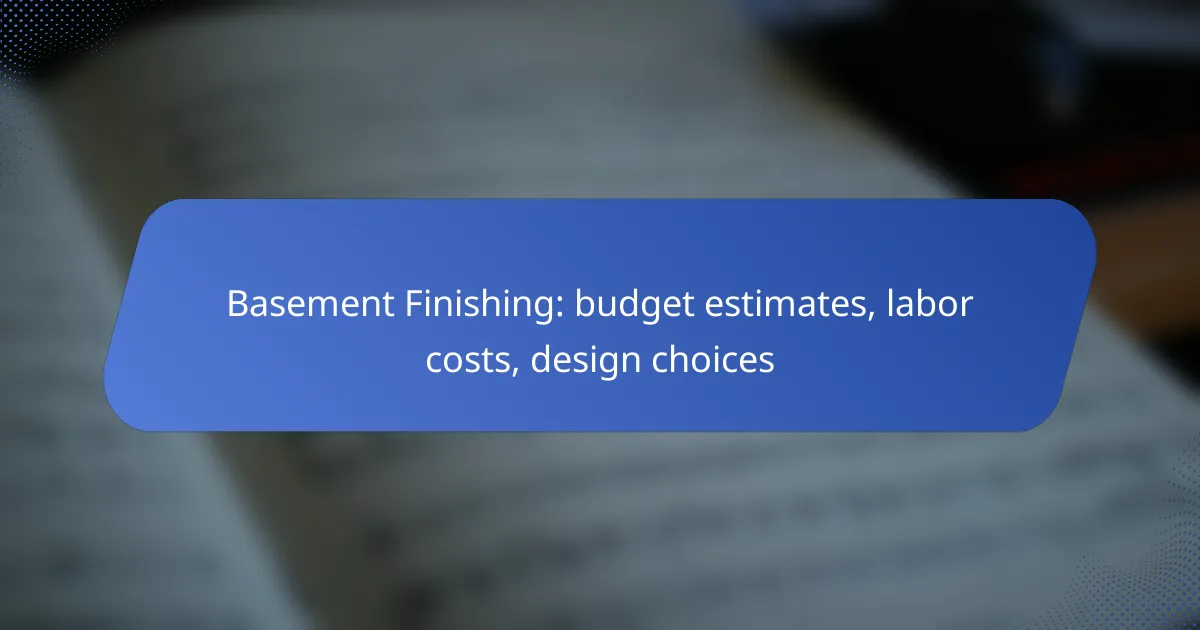Upgrading your bathroom can be a rewarding investment, with costs in the UK typically ranging from £3,000 to £10,000 or more, depending on size, materials, and labor. To ease the financial burden, various financing options are available, such as home improvement loans and credit card financing, each with unique benefits. Selecting high-quality materials is crucial, as they should not only enhance the aesthetic appeal but also withstand the challenges of a moist environment while fitting within your budget.

What are the costs of a bathroom upgrade in the UK?
The costs of a bathroom upgrade in the UK can vary significantly based on factors like size, materials, and labor. Generally, homeowners can expect to spend anywhere from £3,000 to £10,000 or more for a complete renovation.
Average cost breakdown
The average cost of a bathroom upgrade typically includes several key components: materials, labor, and additional fixtures. On average, materials can account for about 40-60% of the total budget, while labor costs usually range from £150 to £250 per day depending on the complexity of the work.
For example, basic fixtures like a toilet and sink may cost around £200 to £500 each, while high-end options can exceed £1,000. Tiling and flooring can add another £1,000 to £3,000 to the overall cost.
Factors affecting costs
Several factors can influence the overall costs of a bathroom upgrade. The size of the bathroom plays a significant role; larger spaces generally require more materials and labor, leading to higher expenses. Additionally, the choice of materials—such as tiles, countertops, and fixtures—can dramatically affect the budget.
Labor costs can also vary based on the region and the contractor’s expertise. It’s essential to obtain multiple quotes and consider the quality of work when selecting a contractor to ensure you get value for your investment.
Cost comparison by region
Costs for bathroom upgrades can differ across the UK, with London typically being the most expensive area. In London, full renovations may range from £8,000 to £15,000, while in other regions like the North East or Wales, costs might be lower, often between £3,000 and £7,000.
When planning a bathroom upgrade, it’s beneficial to research local pricing trends and consult with local contractors to get a clearer picture of what to expect in your specific area.
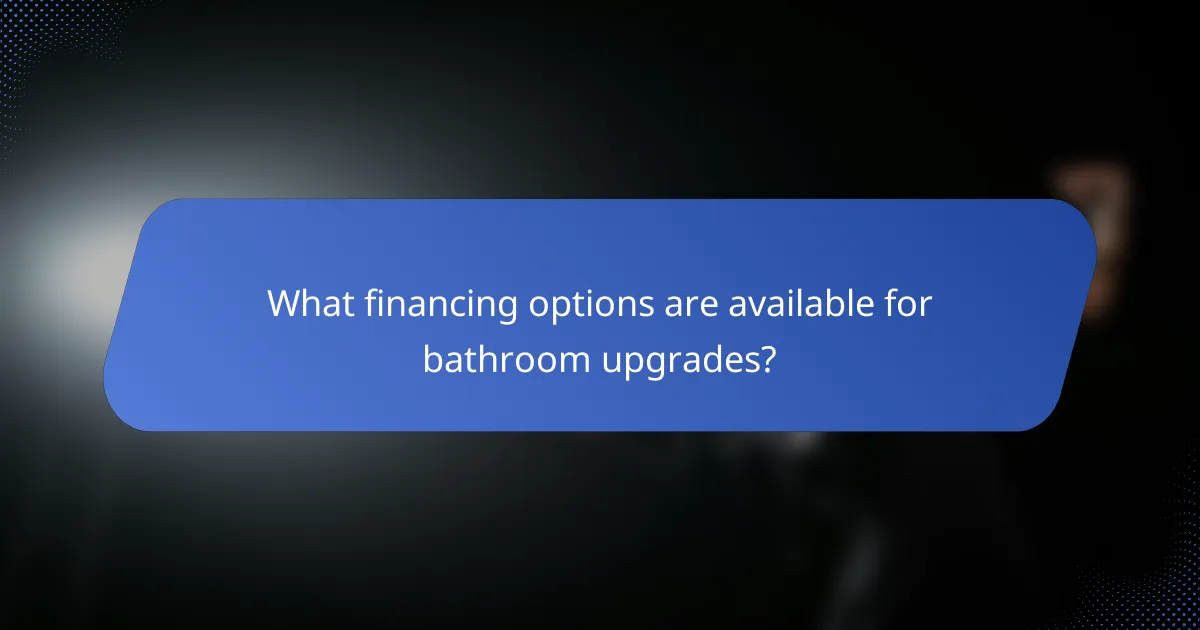
What financing options are available for bathroom upgrades?
Several financing options can help you manage the costs of bathroom upgrades, including home improvement loans, credit card financing, and government grants. Each option has its own benefits and considerations, making it essential to evaluate which suits your financial situation best.
Home improvement loans
Home improvement loans are specifically designed for renovations and can be secured or unsecured. Secured loans typically offer lower interest rates but require collateral, such as your home, while unsecured loans do not require collateral but may have higher rates.
When considering a home improvement loan, check your credit score, as this will influence your eligibility and interest rates. Loan amounts can vary widely, often ranging from a few thousand to tens of thousands of dollars, depending on the lender and your financial profile.
Credit card financing
Using a credit card for bathroom upgrades can be convenient, especially if you have a card with a low interest rate or a promotional 0% APR offer. This option allows for flexibility in payments, but it’s crucial to pay off the balance before the promotional period ends to avoid high interest charges.
Keep in mind that credit card limits might restrict the total amount you can finance. If your renovation costs exceed your credit limit, you may need to explore additional financing options.
Government grants and schemes
Government grants and schemes can provide financial assistance for bathroom upgrades, particularly for energy-efficient improvements or accessibility modifications. These programs often have specific eligibility criteria, such as income limits or property requirements.
To find available grants, check local government websites or consult with a housing authority. While grants do not require repayment, they may involve a lengthy application process, so it’s advisable to start early and gather all necessary documentation.
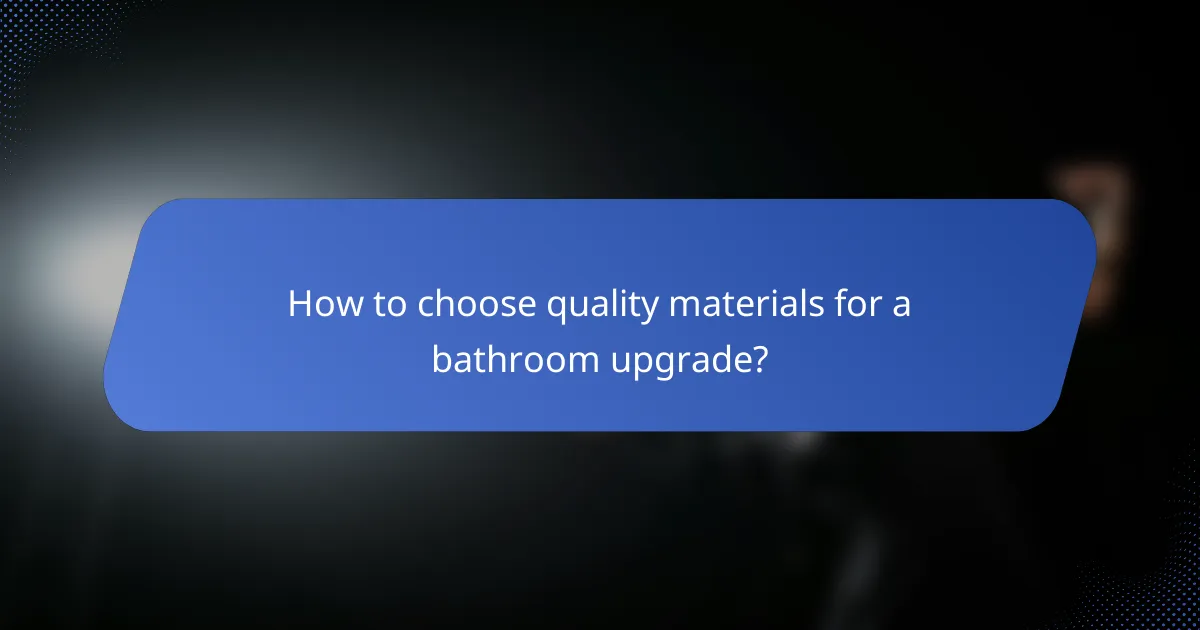
How to choose quality materials for a bathroom upgrade?
Choosing quality materials for a bathroom upgrade involves assessing durability, aesthetics, and cost-effectiveness. Prioritize materials that can withstand moisture while offering a pleasing design that fits your budget.
Top-rated brands for bathroom fixtures
When selecting bathroom fixtures, consider reputable brands known for their quality and reliability. Brands like Moen, Kohler, and Delta consistently receive high ratings for their faucets, showerheads, and toilets.
Researching customer reviews and product warranties can help you gauge the longevity and performance of these fixtures. Investing in top-rated brands often translates to fewer repairs and replacements over time.
Durability vs. cost considerations
Durability is a crucial factor when upgrading your bathroom, as materials must withstand humidity and frequent use. While cheaper options may save money upfront, they often require more maintenance or replacement sooner, leading to higher long-term costs.
For example, ceramic tiles may have a higher initial cost than vinyl but offer greater durability and less wear over time. Weighing the upfront costs against potential longevity can guide your material choices effectively.
Eco-friendly material options
Eco-friendly materials are increasingly popular in bathroom upgrades, offering sustainability without sacrificing quality. Consider options like bamboo for cabinetry, recycled glass for countertops, or low-VOC paints to minimize environmental impact.
These materials not only contribute to a healthier home environment but can also enhance the aesthetic appeal of your bathroom. Look for certifications such as FSC for wood products or Energy Star for appliances to ensure eco-friendliness.

What are the benefits of upgrading your bathroom?
Upgrading your bathroom can significantly enhance your home’s functionality, aesthetics, and value. It often leads to improved energy efficiency and a more comfortable living space, making it a worthwhile investment.
Increased home value
A bathroom upgrade can substantially increase your home’s market value. Potential buyers often prioritize updated bathrooms, which can lead to higher offers or quicker sales.
Consider that a well-executed bathroom remodel can yield a return on investment (ROI) of around 60-70%. This means that if you spend $10,000 on renovations, you might see an increase in your home’s value of $6,000 to $7,000.
Improved energy efficiency
Modern fixtures and appliances can greatly enhance energy efficiency in your bathroom. Low-flow toilets, energy-efficient lighting, and water-saving showerheads reduce water and electricity usage, leading to lower utility bills.
For instance, switching to low-flow fixtures can save a household hundreds of gallons of water each year, translating to significant cost savings over time. Additionally, energy-efficient lighting can reduce electricity consumption by up to 75% compared to traditional bulbs.
Enhanced comfort and aesthetics
An upgraded bathroom improves both comfort and visual appeal. New materials, colors, and layouts can create a more inviting atmosphere, making your bathroom a relaxing retreat.
Consider incorporating features like heated floors, modern vanities, or stylish tiles to enhance comfort and aesthetics. These upgrades not only improve daily use but also contribute to a more enjoyable overall experience in your home.
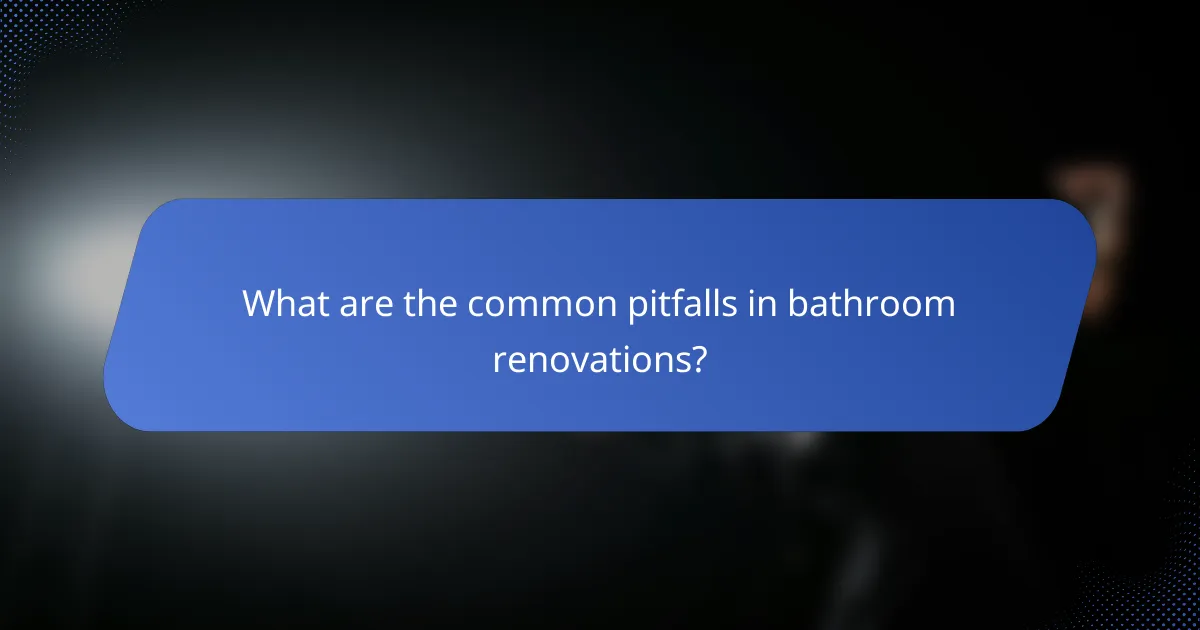
What are the common pitfalls in bathroom renovations?
Common pitfalls in bathroom renovations include budget underestimations, selecting unsuitable contractors, and neglecting plumbing and electrical requirements. Avoiding these issues can lead to smoother projects and better outcomes.
Underestimating budget
One of the most frequent mistakes in bathroom renovations is underestimating the budget. Homeowners often overlook hidden costs such as permits, unexpected repairs, and upgrades to plumbing or electrical systems. To mitigate this, allocate an additional 15-20% of your total budget for unforeseen expenses.
Creating a detailed budget that includes all materials, labor, and contingency funds is crucial. Consider using a spreadsheet to track expenses and compare quotes from multiple suppliers to ensure you stay within your financial limits.
Choosing the wrong contractor
Selecting an inappropriate contractor can derail your renovation project. It’s essential to research potential contractors thoroughly by checking references, reading reviews, and verifying their licenses and insurance. A good contractor should have experience specifically in bathroom renovations.
Request multiple quotes and compare them not just on price but also on the scope of work and timelines. Trust your instincts; if something feels off during the initial meetings, it might be wise to continue your search.
Ignoring plumbing and electrical needs
Neglecting plumbing and electrical requirements can lead to significant issues down the line. Before starting any renovations, assess the current state of your plumbing and electrical systems to ensure they meet local codes and can handle any new fixtures or appliances.
Consulting with licensed professionals can help identify potential problems early. For example, if you plan to install a heated floor, ensure your electrical system can support it. Prioritize these aspects to avoid costly repairs after the renovation is complete.

How to plan a successful bathroom upgrade?
Planning a successful bathroom upgrade involves careful consideration of your budget, design preferences, and material choices. Start by defining your goals and gathering inspiration to create a clear vision for the project.
Step-by-step planning guide
Begin by setting a realistic budget for your bathroom upgrade. Costs can vary widely based on the scope of work, with minor renovations typically ranging from a few thousand to tens of thousands of dollars for extensive remodels. Include expenses for labor, materials, and any unexpected repairs that may arise.
Next, create a detailed design plan. Consider the layout, fixtures, and finishes that align with your style and functionality needs. Utilize online design tools or consult with a professional designer to visualize the space effectively.
Finally, research and select high-quality materials that fit your budget. Prioritize durability and maintenance, especially for surfaces exposed to moisture. For example, opt for water-resistant flooring and mold-resistant paint to ensure longevity and ease of upkeep.







